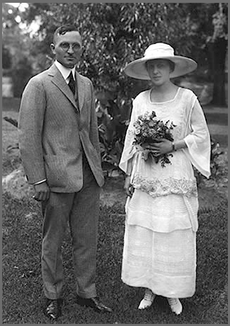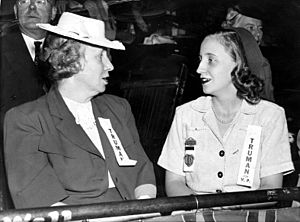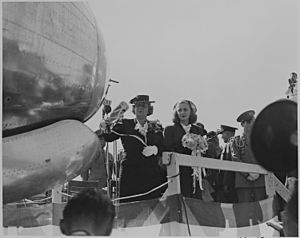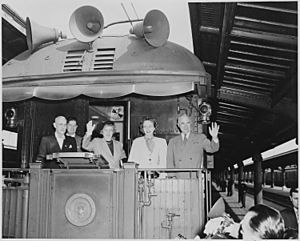Bess Truman facts for kids
Quick facts for kids
Bess Truman
|
|
|---|---|
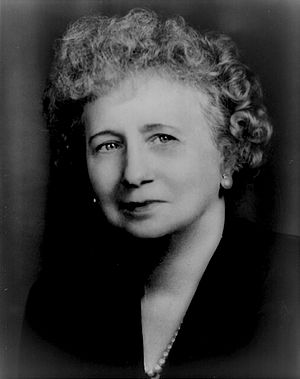
Truman, c. 1940s
|
|
| First Lady of the United States | |
| In role April 12, 1945 – January 20, 1953 |
|
| President | Harry S. Truman |
| Preceded by | Eleanor Roosevelt |
| Succeeded by | Mamie Eisenhower |
| Second Lady of the United States | |
| In role January 20, 1945 – April 12, 1945 |
|
| President | Franklin D. Roosevelt |
| Vice President | Harry S. Truman |
| Preceded by | Ilo Wallace |
| Succeeded by | Jane Hadley Barkley |
| Personal details | |
| Born |
Elizabeth Virginia Wallace
February 13, 1885 Independence, Missouri, U.S. |
| Died | October 18, 1982 (aged 97) Independence, Missouri, U.S. |
| Resting place | Harry S. Truman Presidential Library and Museum |
| Political party | Democratic |
| Spouse |
Harry S. Truman
(m. 1919; died 1972) |
| Children | Margaret |
| Signature | |
Elizabeth Virginia Truman (born Wallace; February 13, 1885 – October 18, 1982) was the wife of Harry S. Truman, who became the 33rd President of the United States. She served as the First Lady from 1945 to 1953. Before that, she was the Second Lady for a short time in 1945.
Bess Truman holds the record for being the longest-lived First Lady and Second Lady in U.S. history. She lived to be 97 years old. She was born and lived most of her life in Independence, Missouri. She knew Harry Truman since they were kids. They married in 1919. Bess helped manage their home and worked in Harry's offices as he became more involved in politics.
When Harry became Vice President in 1944, Bess was a bit worried. She was even more concerned when he became President the next year. As First Lady, Bess preferred to stay out of the public eye. She avoided social events and media attention when she could. She often returned to her home in Independence. Unlike the previous First Lady, Eleanor Roosevelt, Bess did not hold regular press conferences. She believed her role was to support her husband privately.
Bess often talked with Harry about important decisions. She was also very active in his campaign when he ran for reelection. She was happy when Harry decided not to run for another term in 1952. After leaving the White House, Bess lived a quiet life in Independence until she passed away in 1982.
Contents
Bess Truman's Early Life
Bess Truman was born Elizabeth Virginia Wallace on February 13, 1885. Her parents were Margaret Elizabeth Gates and David Willock Wallace. Her father was a local politician. Bess grew up in Independence, Missouri. As a child, she was called Bessie. She had three younger brothers.
Bess was known as a tomboy because she loved sports. She played golf, tennis, basketball, baseball, and enjoyed horseback riding and ice skating. She also learned dance and etiquette. She went to town balls and other social events.
When Bess was 18, her father passed away. After this, Bess took on the responsibility of raising her younger brothers. The family moved into her grandparents' home. This experience taught Bess how important it was for a husband and wife to be close partners. After high school, Bess attended Miss Barstow's Finishing School for Girls. She played on the women's basketball team and studied literature and French.
Bess enjoyed fashion and hats. A friend once said, "Bess always had more stylish hats than the rest of us did." After finishing school, she returned home. She became involved in her community through her bridge club and charity work. Around this time, she started using the name Bess instead of Bessie.
Marriage and Family Life
Harry S. Truman met Bess when his family moved to Independence in 1890. They went to school together. They were not very close friends back then. Harry often carried her books, but they came from different backgrounds.
After high school, Bess had many people interested in her. But she didn't fall in love with any of them. In 1910, Harry found an excuse to visit Bess. They reconnected and started spending time together. Harry didn't have much money, so he tried to impress Bess. He bought tickets to shows and even built her a tennis court.
Harry proposed to Bess in 1911, but she said no. He wanted to propose again when he had more money. They became unofficially engaged in 1913. Over the next few years, they wrote many letters to each other. Harry traveled for his work in mining and oil. Bess wanted to marry before Harry left for World War I in 1917. But he didn't want to risk her becoming a young widow. While he was away, she helped the war effort by selling war bonds.
Bess and Harry married on June 28, 1919. They got married at Trinity Episcopal Church in Independence. After their honeymoon, they moved into Bess's childhood home. Bess wanted to take care of her mother. Their only child, Margaret, was born in 1924. Bess had two miscarriages before Margaret was born. Bess was the main parent who set rules for Margaret. Harry, on the other hand, would often spoil her.
Bess worked with her husband in several jobs. This helped the Truman family earn more money. She managed accounts for a business Harry owned. Later, she worked as his aide when he became a county judge. Working with Harry in politics was sometimes stressful. They even worried about their daughter being kidnapped once. Besides helping Harry, Bess also managed their home and money. She also helped start a local service league and a chapter of the Daughters of the American Revolution.
Moving to Washington, D.C.
Harry was elected as a senator from Missouri in 1934. Bess stayed in Missouri with her mother for the first year. After visiting Harry, she decided to stay in Washington, D.C. They lived in rented apartments in Washington when Congress was in session. They would return to Independence for the rest of the year.
While Harry was a senator, Bess joined several clubs. She also worked on Harry's staff as a clerk. She answered personal mail and helped edit reports. She became friends with the wives of other senators and cabinet members. Bess helped Harry write his speeches. However, she never gave any speeches herself.
In 1944, Harry was asked to be the Democratic candidate for Vice President. He had not sought the position. Bess was not entirely happy about this. She wanted to return to their life in Missouri. She also worried that President Franklin D. Roosevelt might die. This would make her husband the President. Bess's job on Harry's staff was debated during the campaign. But he kept her on his staff.
After Harry became Vice President, Bess became the Second Lady of the United States. She had many social duties. She attended many events as a representative for the Roosevelts. Bess was Second Lady for only 82 days. Then, President Roosevelt died, and Harry became President.
First Lady of the United States
Her Social Role
President Roosevelt died on April 12, 1945. This made Harry Truman the President and Bess Truman the First Lady. Bess was very sad when she heard the news. Her first act as First Lady was to offer her sympathy to Eleanor Roosevelt. Then, she attended her husband's inauguration. The Trumans moved into Blair House on April 16. This gave Eleanor Roosevelt time to move out of the White House. They moved into the White House on May 7.
Bess had limited social duties at first. This was because World War II was still happening. Also, the country was mourning President Roosevelt. She stayed in the White House until the end of April. Then, she made her first trip back to Independence.
After World War II ended, Bess was in charge of bringing back the White House social season. She organized receptions and events. She was inspired by the history of the White House. She chose to host fewer large dinners. Instead, she had informal luncheons because of food shortages after the war. She made sure all her guests were treated with respect. This included political opponents. Bess received about 100 letters every day. She spent a lot of time replying to each one.
Bess felt very nervous at public events. She wanted to avoid being the center of attention. Once, she had to christen airplanes by breaking champagne bottles against them. The first bottle didn't break easily. She had to hit it several times in front of a crowd. Harry would tease her about this later. Eventually, she learned to laugh about it too.
Bess did not like the lack of privacy at the White House. Harry said she was "not especially interested" in the "formalities and pomp" of being First Lady. She did her social duties, but only what she felt was necessary. She liked having servants but still did some chores herself. She dressed simply, preferring conservative gowns and suits. When the White House was rebuilt, the family lived in Blair House. They kept their social life to a minimum during this time.
Dealing with the Press
Bess was very different from the previous First Lady, Eleanor Roosevelt. Eleanor was very active and public. Bess, however, held only one press conference. This was after many requests from the media. She only gave written answers to questions. Most of her replies were very short, like "no comment." When asked why she didn't want to give press conferences, she said, "I am not the one who is elected. I have nothing to say to the public."
Bess did not support women having bigger roles in politics. She believed there would never be a woman president. She once said a woman's role in public is to "sit beside her husband, be silent, and make sure her hat is on straight." When asked if she wanted her daughter Margaret to be president, she said, "most definitely not." Her answer to what she wanted to do after her husband left office was "return to Independence."
Bess had limited contact with women journalists. This was on the advice of her husband's press secretary. But she didn't give them much information. She was the first First Lady to allow reporters to have copies of her schedule. Her social secretary often gave press briefings for her. Many journalists were surprised by her limited interaction with the media. Others approved, feeling that Eleanor Roosevelt had been too public.
Her Political Influence
Privately, Bess was an unofficial advisor to her husband. She never told him what to do as president. But she often shared her opinion on things he was unsure about. Bess also helped Harry with his speeches. This included his speech on the Truman Doctrine. She reviewed and commented on Harry's work every day. She played an important role in his 1948 election campaign.
Harry later said he asked for her input on major issues. These included the Marshall Plan and the Korean War. Many of Bess's ideas became government initiatives. She suggested using theater groups abroad to improve foreign relations. She also suggested involving the National Institutes of Health in fighting disease. She was also the one who suggested appointing Charlie Ross as the White House Press Secretary.
Bess was involved in a controversy when she attended a reception for the Daughters of the American Revolution. This group had refused to let Hazel Scott, a black pianist, perform. Bess's attendance was seen by some as supporting this decision. Bess felt that a First Lady's actions should not be about political issues. She wanted her personal time to be separate from her political role. She was upset about being compared to segregationists. This made her even more determined to avoid the public.
As First Lady, Bess was the Honorary President of several groups. These included the Girl Scouts and the American Red Cross. She worked with various organizations. But she never chose one specific cause to focus on. She was very active in her husband's reelection campaign in 1948. She traveled the country with Harry on a train tour. He introduced her to crowds as his "Boss." Her presence helped Harry look like a family man.
Four years later, Harry was unsure about running for reelection. Bess really wanted to go home. This was a major reason he decided not to run. When Harry announced he wouldn't run in 1952, one of Bess's friends said she was trying not to show how happy she was. However, after retirement, she said she enjoyed the culture of Washington.
Her Personal Life
Bess spent a lot of time in Independence while she was First Lady. She allowed her daughter to handle some of the social duties. Even in Washington, most of her time was for her family. She continued to care for her mother until her mother passed away in 1952. When Bess was in Washington, she had a weekly Spanish class with her friends. She also hosted her bridge club from Independence at the White House. She would give them a tour of Washington.
During the first months of her husband's presidency, Bess felt a bit neglected. She told Harry how she felt. But his schedule made it hard for them to spend time together. This led to an argument in December 1945. Harry later wrote her a harsh letter. But he called Margaret and had her burn it before Bess could read it. After this, they made up. Harry made sure she had a bigger role in his administration. White House staff often described the Trumans as a close family. They even called Harry, Bess, and Margaret the "Three Musketeers."
Later Life
After leaving the White House in 1953, the Trumans returned to their home in Independence. The former president worked on building his library and writing his memoirs. A large crowd of admirers met them when they arrived home. Bess really enjoyed this.
In 1955, the Trumans went on vacation to Hawaii. That summer, they took a road trip across the United States. But they were stopped by people wanting to see them everywhere they went. The Trumans toured Europe in 1956 and again in 1958. Bess fully recovered after surgery in 1959.
The Trumans returned to the White House in 1961. They were invited by the Kennedys. When President Lyndon B. Johnson signed Medicare into law in 1965, the Trumans were the first seniors to get Medicare cards. Johnson gave them the cards at the Truman Library. Harry passed away in 1972 at age 88. Bess was 87. They were the oldest couple to have lived in the White House at that time.
Bess was upset by the 1972 presidential election. She did not like the policies of the candidate, George McGovern. She also felt that Thomas Eagleton was treated unfairly. She agreed to be the honorary chairman for Eagleton's Senate reelection campaign in 1974. She also supported another candidate, James W. Symington, in 1976.
While Harry's presidency was closely looked at after he left office, Bess lived long enough to see people view him more positively in the 1970s. Jimmy Carter asked for her support in the 1980 presidential election, but she did not give it.
Bess continued to live quietly in Independence for the last ten years of her life. Her daughter and grandchildren visited her often. She received many visitors. She often remembered names and details about people she had met before. In her final years, she used a wheelchair because of Arthritis. She enjoyed reading mystery novels and following the Kansas City Royals baseball team. She also reread an old love letter from her husband every day.
Bess died on October 18, 1982, from congestive heart failure. She was 97 years old. A private funeral service was held on October 21. She was buried next to her husband in the courtyard of the Harry S. Truman Presidential Library and Museum in Independence, Missouri. She is still the longest-lived First Lady in U.S. history.
Bess Truman's Legacy
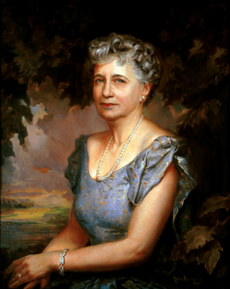
Bess Truman kept a very low profile as First Lady. People often said that very little was known about her. Many reports about her at the time had mistakes because reporters couldn't get much information. Her refusal to talk about her political beliefs made people think she didn't have strong opinions.
Bess destroyed many of her own letters after leaving the White House. She wanted to make it harder for historians to study her life. Most of her surviving letters were saved by her daughter. She only appeared on television once, also because her daughter asked her to. Much of what we know about Bess comes from a book written by her daughter and letters Harry wrote to her. Because of this, historians have different ideas about Bess Truman.
She was often compared to her predecessor, Eleanor Roosevelt. Eleanor was very active in politics and a public figure. Bess's influence was mostly behind the scenes. She would gently correct her husband when he lost his temper. White House staff found her friendly, which was different from her shy public personality. Her advice may have influenced her husband's decisions. However, the full extent of her role is not fully known to history.
See also
 In Spanish: Bess Truman para niños
In Spanish: Bess Truman para niños
- Bibliography of United States presidential spouses and first ladies



